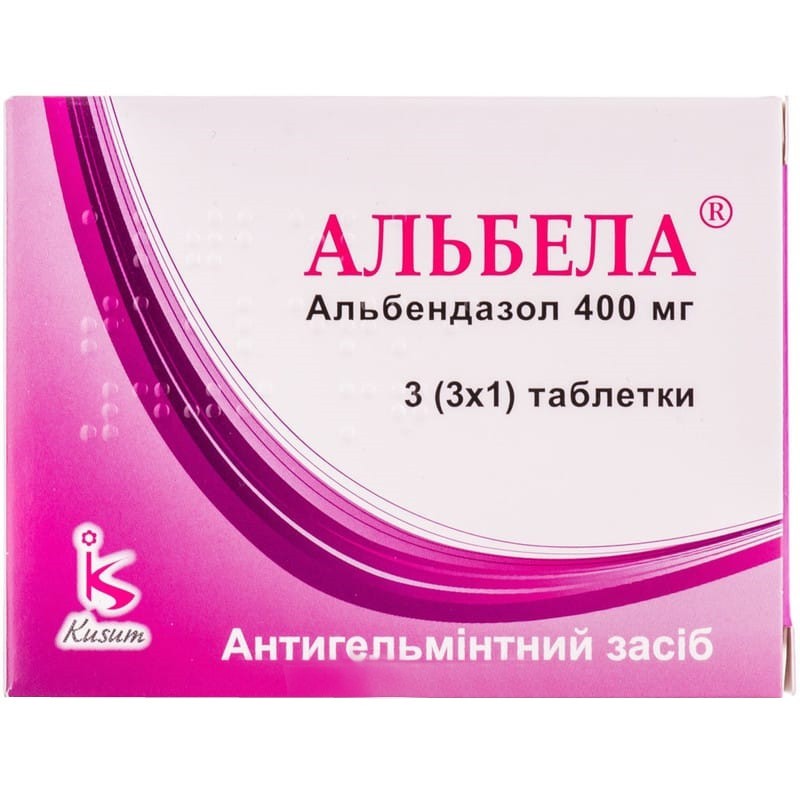



 Secure and encrypted payment processing
Secure and encrypted payment processing We ship to over 40 countries including the USA, UK, Europe, Australia and Japan
We ship to over 40 countries including the USA, UK, Europe, Australia and Japan Guaranteed refund or reship if you haven't received your order
Guaranteed refund or reship if you haven't received your orderAlbendazole is an antiprotozoal and anthelmintic drug derived from benzimidazole. the drug acts on both intestinal and tissue parasites in the form of eggs, larvae and adult helminths. the anthelmintic effect of albendazole is due to inhibition of tubulin polymerization, which leads to a violation of metabolism and death of helminths.
Albendazole is active against such intestinal parasites: nematodes - Ascaris lumbricoides, Trichuris trichiura, Enterobius vermicularis, Ancylostoma duodenale, Necator americanus, Strongyloides stercoralis, Cutaneus Larva Migrans; cestodes - Hymenolepsis nana, Taenia solium, Taenia saginata; trematodes - Opisthorchis viverrini, Clonorchis sinensis; protozoa - Giardia lamblia (intestinalis or duodenalis).
Albendazole is active against tissue parasites, including cystic and alveolar echinococcosis, caused by invasion of Echinococcosus granulosus and Echinococcosus multilocularis, respectively. Albendazole is an effective treatment for neurocysticercosis caused by larval invasion of Taenia solium, capillariosis caused by Capillaria philippinensis, and gnatostomosis caused by invasion of Gnathostoma spinigerum.
Albendazole destroys cysts or significantly reduces their size (up to 80%) in patients with granular echinococcosis. After treatment with albendazole, the number of non-viable cysts increases to 90% compared with 10% in patients who have not undergone treatment. After the use of albendazole for the treatment of cysts caused by Echinococcus multilocularis, complete recovery was noted in a smaller part of patients, in the majority - improvement or stabilization of the condition.
Pharmacokinetics With oral administration, albendazole is poorly absorbed (5%). The systemic effect increases if the dose of the drug is taken with fatty foods, which increases the absorption of the drug by 5 times. It is rapidly metabolized in the liver during the first passage. The main metabolite is albendazole sulfate, which is the main effective substance in the treatment of tissue infections. T½ is 8.5 hours. Albendazole sulfate and its metabolites are mainly excreted in the bile and only a small part - in the urine. It was found that with prolonged use of the drug in high doses, its elimination from cysts lasts several weeks.
Elderly patients. Some clinical data suggest that the pharmacokinetics in elderly patients are similar to those in young healthy volunteers.
Renal failure. The pharmacokinetics of albendazole in this group of patients has not been studied.
Liver failure. The pharmacokinetics of albendazole in this group of patients has not been studied.
Intestinal forms of helminthiases and larva migrans skin syndrome (short-term treatment with low doses): enterobiosis, hookworm and necatorosis, hymenolepidosis, teniosis, strongyloidosis, ascariasis, trichocephalosis, clonorchiasis, opisthorchiasis, larva migrans skin syndrome, giardiasis in children.
Systemic helminth infections (long-term treatment with high doses):
cystic echinococcosis (caused by Echinococcus granulosus):
alveolar echinococcosis (caused by Echinococcus multiocularis):
neurocysticercosis (caused by Taenia solium larvae):
capillarosis (caused by Capillaria philippinensis), gnatostomiasis (caused by Gnathostoma spinigerum and related species), trichinosis (caused by Trichinella spiralis and T. pseudospiralis), toxocariasis (caused by Toxocara canis and related species).
Intestinal infections and skin syndrome larva migrans. take the drug with food. it is advisable to apply at the same time of day. if recovery does not occur after 3 weeks, the doctor should prescribe a second course of treatment.
Some patients, especially children, may have difficulty swallowing an entire tablet. In this case, the tablet can be chewed with a small amount of water or it can be crumbled.
Use in adults and children over the age of 3 years.
| Infection | Patient age | Doses and duration of administration |
|---|---|---|
| Enterobiosis, hookworm, necatorosis, ascariasis, trichocephalosis | Adults and children over 3 years old * | 400 mg (1 tablet) once a day once |
| Strongyloidosis, teniosis, hymenolepidosis | Adults and children over 3 years old * | 400 mg (1 tablet) 1 time per day for 3 days
With hymenolepidosis, a repeated course of treatment is recommended in the interval from the 10th to the 21st day after the previous course |
| Clonorchiasis, opisthorchiasis | Adults and children over 3 years old * | 400 mg (1 tablet) 2 times a day for 3 days |
| Larva Migrans Cutaneous Syndrome | Adults and children over 3 years old * | 400 mg (1 tablet) 1 time per day for 1-3 days |
| Giardiasis | Only children ages 3-12 * | 400 mg (1 tablet) 1 time per day for 5 days |
* For children aged 2-3 years, use albendazole preparations in the appropriate dosage.
Patients of advanced age. The experience of using the drug for the treatment of the elderly is limited. Dose adjustment is not required, however